From to vision visibility
ARA and Sign On redefine excellence in Signage Services.



ARA and Sign On redefine excellence in Signage Services.


We are constantly setting new benchmarks in quality, innovation, and customer service in the signage domain.
Nothing brings Sign On more pride than when one of our signs breathes new life into a brand, for all New Zealand to see. Whether you’re filling up petrol, going for a walk or catching your next flight, our work can be seen from every angle.

The recent integration of ARA Shelters & Structures and Sign On is set to create new opportunities, enhancing ARA’s capabilities in providing comprehensive solutions that now include:













Welcome to the Winter Issue of Image NZ. It’s been a busy time for the industry over the past few months, with the highlight being the NZSDA Conference and Awards night in Napier, which was a resounding success.
From the AGM, where you get to have your say about the industry, to speed dating with suppliers, the conference included inspirational speakers and relevant and interesting social events. Keep an eye out for dates for next year’s 60th Birthday conference in beautiful Nelson. The conference culminated in the annual NZSDA Sign and Display Awards, a fantastic night of industry celebration. Pages 12 and 13 feature all of the Gold Award Winning projects, which were of an exceptionally high standard, inspiring us all. We congratulate all the Award Winners for their outstanding work.
After an eight-year covid interrupted hiatus, drupa was held in Dusseldorf from May 28 – June 6, which saw
a vast range of new product launches at the show, which stretched over a massive fourteen halls. Key themes for the show included workflow automation, software integration, and sustainability. Check out our round-up of all the new wide format equipment released at drupa on page 7 of this issue.
Do you want to keep up to date with what’s happening in your industry? Make sure you visit imagemagazine. co.nz to register for our weekly newsletter. As always, we love to hear about your latest project, so please reach out to us at editor@imagemagazine.com.au
Best regards,
Janet Maitland Publisher ImageNZ

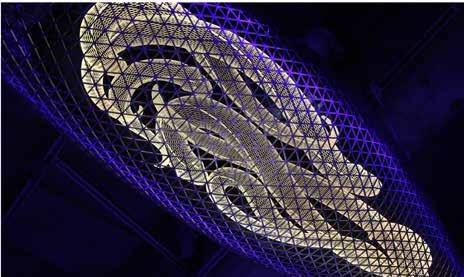
Wide format highlights from drupa
NZSDA Association News

NZSDA Awards of Excellence Gold Award Winners Innovative Wayfinding Solutions A legacy of signage excellence The journey of Sign On Big Ideas Group pushing the boundaries with Emirates Team New Zealand

disclaimer
The opinions expressed in ImageNZ are not necessarily the views of the publisher. Every effort has been made to ensure the accuracy of information contained in this magazine. No responsibility is accepted by the publisher for any omissions, inaccuracies, typographical errors or printers errors. Nor will responsibility be accepted for any changes to information after publication.

Computaleta has been reappointed as the Preferred Supplier for the Speedy Signs network. This agreement spans three years and encompasses the provision of self-adhesive vinyl, digital films, and various signage consumables throughout the network.
The decision to once again select Computaleta was based on their extensive product range, national presence, and the expertise and responsiveness of their staff.
Director Arlette Farland expressed satisfaction with their partnership over the past two years. Looking ahead, Arlette highlighted their aim to provide comprehensive training in specific areas over the next three years, aiming to benefit both Speedy Signs staff and the broader industry.
“Skilled staff shortages have been a real problem for every business. Our job as a supplier is to work with our customers to ease that burden by upskilling or training existing staff across multiple areas of their business, such as lighting and print production. In the end, our goal is to assist our customers in diversifying their services and ultimately becoming more profitable businesses.”
Speedy Signs Group CEO Grant Archibald said, “We chose Computaleta as our preferred supplier because of their product range, nationwide account servicing and overall expertise. Their comprehensive support makes them an invaluable partner for our network.”

Avery Dennison will launch a new digital print film at Visual Impact in Brisbane, calling the product a “significant leap in sustainable innovation for the Australia and New Zealand markets”. The SP 1504 Easy Apply RS is designed for environmentally conscious vehicle wrapping and corporate branding.
This new solution delivers a 53% reduction in greenhouse gas (GHG) emissions compared
to its PVC-based counterparts. It is also free from chlorine, phthalates, and other halogens, reducing emissions of volatile organic compounds (VOCs). The film features Avery Dennison’s proprietary Easy Apply Adhesive, utilising Air Egress technology to remove air bubbles easily during application for a hasslefree installation. The SP 1504 Easy Apply RS also offers exceptional printability, producing
vibrant images and enabling installers to deliver outstanding results.
The film will be available in A/NZ from 22 July 2024 onwards. The company notes that the innovative film matches the print quality and durability of leading PVC-based products without any price increase, making it an appealing option for sustainability-focused brands.

HP has announced a strategic multi-year global partnership with Canva to empower millions of Canva users worldwide to seamlessly design online, create visual content, and print locally.
“This partnership will deliver huge strategic value and fuel customer growth across both organizations,” said Cliff Obrecht, Canva co-founder and Chief Operating Officer.
Canva, founded in 2013, has over 185 million monthly users, including 95 percent of the Fortune 500. The launch of Canva Print in 2017 has allowed users to design and print a wide range of products—from
business cards, brochures, flyers, stickers, marketing collateral, with customization options, and even apparel – experiencing exponential growth with millions of orders annually.
Through this collaboration, the Canva community will gain expanded access to professionally printed products from HP PSPs across the globe. Canva aims to expand its print service to 150 countries by 2026, enabling shorter turnaround times and significantly reducing its carbon footprint through localized operations.

Roland DG has announced the launch of the EU-1000MF large format UV-LED flatbed printer.
The EU-1000MF offers high-quality printing and support. It can print on a wide range of materials up to 95mm thick for various applications, including sign graphics, event and store displays, décor, and small-lot and high-mix custom goods.
The EU-1000MF is available in two models, 4-colour or 6-colour, with printheads in a staggered array for printing up to 27.6m2/h in 720 x 600 dpi CMYK mode and enabling it to handle approximately nine
rigid 1,220 x 2,440 mm boards per hour. The UV ink is cured instantly, eliminating the need for post-print drying. At the same time, the ability to print directly onto various materials such as acrylic, PETG, PVC, foam, PC, wood, and aluminium composite boards further reduces postprocessing time and costs.
Additionally, the EU-1000MF comes with advanced features, including bundled VersaWorks RIP, low-cost GREENGUARD Gold certified E-US inks, a liquid-cooled LED lamp system, a four-zone vacuum bed, an anti-static ionisation system to reduce static interference and solenoid alignment pins for easy media handling.
Mimaki has announced the global launch of its carton ink cartridges. This revolutionary move replaces traditional plastic cartridges with an environmentally friendly paper alternative, marking a significant stride towards sustainability in the printing industry.

The carton ink cartridges were initially introduced to the Japanese market in May 2023. Designed for use in Mimaki’s ecosolvent printers, these cartridges retain exceptional performance while significantly reducing environmental impact.
“We remain committed to innovation in all parts of the production process, from the ink cartridges to the technology itself, in
Arlon has announced the launch of VITAL, its innovative new non-PVC product range.
Products in the VITAL Range include:
DPF V9700 : A premium cast polyurethane film, featuring FLITE Technology®, designed for exceptional performance in full or partial vehicle wraps and fleet vehicle branding.
SERIES V3370: A premium cast polyurethane gloss overlaminate, that provides superior scratch recovery properties, chemical resistance, and extended durability. Like DPF V9700, this overlaminate is perfect for vehicle wraps and fleet branding and can be combined with a variety of other Arlon films for different applications.
Neil Gomez, Director of Sales and General Manager Arlon ANZ says “We are very excited for the launch of this product in Australia and New Zealand as not only does it provide our customers with a non pvc alternative, it is also highly durable lasting twenty percent longer and offers great value. This combined with our adhesive FLITE technology which enhances installer productivity, provides a compelling option on many levels.
pursuit of a positive environmental impact. To respond swiftly to social and environmental needs, we see the importance of advanced technologies such as automation, highefficiency and high-speed printers, and waterless textile technology,” says Arjen Evertse, General Manager Sales EMEA at Mimaki Europe.
“Through all these sustainable initiatives, we continue to be dedicated in making a positive contribution to the global print community and fostering a sustainable future for generations to come.”
By transitioning from plastic to paper, Mimaki has achieved a remarkable 68%
reduction in plastic usage per cartridge. This innovative approach is projected to eliminate approximately 44 tons of plastic and 65 tons of CO2 emissions annually, underscoring Mimaki’s commitment to a greener future.
Moreover, the lighter weight of carton ink cartridges translates to an estimated 8-ton reduction in CO2 emissions during transportation, further contributing to a decarbonised society.
In recognition of its groundbreaking design and eco-conscious packaging, the ink cartridge received the prestigious Industrial Packaging Category Award at the 2023 Japan Packaging Contest.
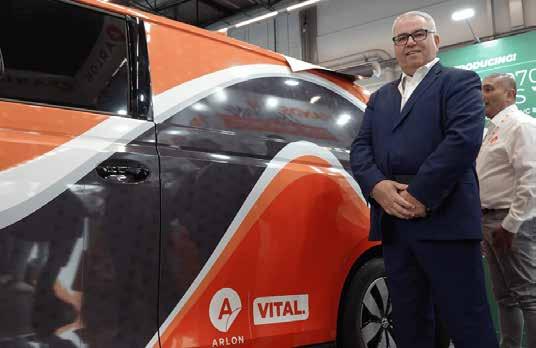
Arlon launches Vital - a new non-PVC range
ORAFOL has established a sales company in New Zealand. By setting up this new branch in Auckland, the company says it is responding to the significantly increasing market potential for premium films and special plastics in the Asia Pacific region. In Asia, the business already oversees sales and production companies in China, Japan, Taiwan, India, and Australia. The five ORAFOL sites in Australia, including its headquarters in Sydney, form the foundation for the expansion of its Asia Pacific presence. Alex McClelland, who has been the Managing
Director of ORAFOL Australia since 2019, is responsible for this expansion. He has been appointed as the Executive Vice President Asia Pacific at ORAFOL, effective from May 1, 2024.
Alex McClelland, Executive Vice President Asia Pacific, emphasizes: “With ORAFOL New Zealand, we are creating a key pillar in the Asia Pacific economic region – for ORAFOL and, of course, for our customers who can rely on our proximity and the constant availability of our premium films.”


Digital Image Magazine visited drupa 2024 which was held in Düsseldorf for the first time since 2016. Billed as the world’s largest printing show the primary focus was on commercial printing, labels and packaging and wide format printing.
There were three key themes that emerged from the show. The first being workflow automation with a wide range of robotics, automation and inline finishing on display. The second was software, combining web to print front ends with printer hardware, and the use of software for remote monitoring, prognostics and preventative maintenance for equipment. The final theme was sustainability with a heavy focus on minimising the use of water, energy and reducing and reusing substrates and waste. In terms of emerging opportunities, it is hard to look past short run labels and packaging, as domestic manufacturing increases post COVID, and personalisation of the relationship between brands and their consumers continues to increase rapidly. There were a huge range of printing and finishing equipment able to handle a wide variety of substrates on show. Here are some of the highlights we saw at the show.
Canon launched a new feature now available for the Colorado M-series printer called FLXture, a five-ink-layer printing technology that adds micro-texture to large format prints for subtle surface detail and is well suited for elevated print applications. FLXture uses the PRISMAguide XL software, which intelligently prepares the layers of UVgel ink for printing.
Also showcased was the new Arizona 2300 FLXflow flatbed wide format printer with enhanced materials handling and registration capabilities with optional PRISMA elevate XL software.
Canon also launched the new UVgel Packaging Factory extending the Colorado’s already broad application capabilities to deliver the digital equivalent of litho lamination. Producing customised printed sheets of liner material for subsequent lamination to a corrugated base substrate.
Durst introduced the P5 SMP. With a print width of 3.5 m and a maximum productivity of up to 2,000 m2/h it is a hybrid solution, that can process both roll and sheet material and has the versatile functions of the P5 platform. Also on stand was the new Aleph Laforte 600 Paper, which is suitable for poster and billboard printing.
EFI showcased a number of new products including the EFI Vutek X5r roll to roll 5m printer which is 30% faster than the Vutek Q5r. The new EFI Vutek Q3hX/XP a high speed flatbed/roll fed inkjet printer and the EFI VUTEK FabriVu340i+ suitable for backlit graphics, front lit graphics and flag applications. Also on show was the new EFI Reggiana ecoTERRA, a single step direct to fabric solution which has a small footprint and excellent sustainability credentials when it comes to water and energy use.


Elitron showcased its new Kombo TAV cutter, featuring advanced control and motion systems for increased productivity and efficiency.
Epson showcased various new products at drupa, many of which were in the area of microproduction including the new hybrid DTG/DTFilm SureColor F1000, the A4 UV flatbed SureColor V1000, the A3 UV flatbed SureColor V2000 and the micro-production DTG/DTFilm SureColor F2200. The company also introduced the Monna Lisa 13000, a direct-to-fabric printer, and the SureColor F10000 dye-sublimation printer. Also on show were two new concept printers, a new 1.6m
eco solvent concept printer and a new 1.6m dye sublimation printer.
Fujifilm launched a range of new products including the Dimatix SKYFIRE SF600 printhead, which aims to improve printing speed and precision. This printhead promises higher performance for industrial applications, offering a significant upgrade in efficiency and quality.
Fujifilm also announced a new inkjet ink technology called AQUAFUZE, which combines water-based and UV curable ink for wide format inkjet printing applications.
Also on stand was the new Acuity Ultra Hybrid Pro which can be seamlessly integrated

with a new automation system. This system is designed for the automatic handling of rigid materials, allowing one single operator to run the machine for a full pallet-to-pallet process.
Fujifilm also announced a new 1.6m Acuity Triton Printer. Featuring its new AQUAFUZE ink combined with hardware made by Mutoh this is Fujifilm’s first foray into smaller wide format ink jet printers.
HP announced a new partnership with Canva designed to create a seamless experience enabling Canva users to print locally. It also showcased new backlit textile and new print modes on the HP Latex 2700 as well as new 10 litre ink supplies.
Inkcups unveiled the XJET Switch, a digital printer designed for direct-to-bag and hard goods applications. This UV flatbed printer offers high-quality CMYKWW prints on various substrates, providing a versatile solution for reusable bag decoration.
Mimaki showcased its new M2COA robotic automation system for use with the UJF 7151 plus II and UJF 6042 Mk II e UV LED printers. Mimaki also displayed its NeoChromato Process, which facilitates textile material recycling and significantly reduces CO2 emissions. Also on stand were the new UCJV330-160 integrated sign printer/cutter and the JFX600-2513 flatbed UV printer with the ability to print on media as thick as 60mm and multiple beds sizes which can be configured to simultaneously print and load/ unload therefore maximising productivity.
MUTOH launched the new HydrAton 1642 inkjet printer, equipped with newly developed ink based on Fujifilm's AQUAFUZE technology. This technology uses water as the main ingredient, offering low odour and high abrasion resistance without the need for primers or overcoats. It is suitable for a wide range of applications, including wallpaper and indoor signs.
Mutoh also launched the new XpertJet 1682UR. Mutoh’s first roll-to-roll UV LED printer based on the award-winning XpertJet printer platform. This dual-headed 1.6m wide printer uses MUTOH’s environmentally friendly SVHC1 free US61 series inks, available in C, M, Y, K, White and Varnish 800 ml inkpacks.
swissQprint unveiled a new automation module. Designed to complement the Kudu it removes processed media up to 3.2×2 meters from the flatbed printer’s table eliminating the need for manual unloading. Also new is the swissQprint 36 month warramty.
Zünd presented its new Q-Line generation of cutters with Board Handling System BHS180. Combined with the UNDERCAM optical capture system, the board-loading extension enables semi-automatic board feeding, job identification via QR code, and registration during the production process. This significantly increases productivity, particularly in cases where cutting and creasing are done on the reverse side of the board.


The 2024 Sign Makers Conference and Sign Display Awards of Excellence are officially over, and what a week we had! We would like to thank everybody involved, hosts, sponsors, and attendees. Your contributions helped make this event one of our best conferences yet!
It is so important for our members to attend these events; this is where the true value of our membership lies. The networking and connections made are invaluable. We strongly encourage all our members not to miss this opportunity to learn and grow amongst others who have experienced the same challenges and experiences you have.
This year we introduced a new experience to the conference lineup; a speed networking session that saw sign makers make their way around tables of suppliers for 15-minute networking slots. During this

time attendees learnt about new products and promos, played games, won prizes, and enjoyed snacks and drinks. This session was a highlight for both sign makers and suppliers, with many asking us to keep it in the agenda for future conferences!
Feedback from this event has been overwhelmingly positive and encouraging from both sign makers and suppliers, and we can’t wait to see you all back again for our 60th Birthday Party next year in Nelson!
We recently hosted a webinar with Nigel Davies from M-Power, who explained and promoted his workflow software. It was an insightful session, particularly for those looking for modern, streamlined business solutions. We had really high attendance and lots of great questions asked. For any members unable to make it, the recording is now available in the members section of our website.
We also ran a webinar on cashflow tips and debtor management, presented by cohosts Anna Ramm (Network HR) and Tom Maling (Brown and Associated Accountants). The session was loaded with easy to absorb, actionable tips on maximising cashflow and managing debt. This recording is also available for members to access on our website.
We have recently partnered with 2 Degrees to offer NZSDA members discounted broadband, mobile plans, and power. We also have an offer from NZ Safety Blackwoods in the works! These are just some of many new benefits we are offering to our members this year. While our focus is on providing education and support, and fostering community and inclusivity, we know that
these discounted offerings can make all the difference for smaller businesses struggling to get through the year.
Thank you to everyone who came along to our Christchurch and New Plymouth regional meetings! It was great to meet more of our members. I was particularly impressed with the strong sense of community amongst the Taranaki-based sign makers. All so supportive of one another despite being competitors. Congratulations to the following members who received Certificates of Recognition this month!
• The Sign Team - 55 years
• The Sign Shop Ltd - 52 years
• DT Signs - 47 years
• Riccarton Signs Limited - 47 years
• Clarkson Signs - 47 years
• Zodiac Signs Ltd - 46 years
• Horton Signs - 36 years
• Signtech the Signmasters Ltd - 30 years
• Design Studio - 24 years
• Vital Signs - 20 years
• Fulton Hogan Signs & Graphics - 14 years
• Future Grafix - 13 years
• Identity Signs - 12 years
• Sign Network Limited - 12 years
• Signwise Christchurch - 11 years
• Signlink Graphics - 10 years
Our next regional meeting will be in Hamilton on 25 July.
Ki te kore ngā pūtake e mākūkūngia, e kore te rākau e tupu. If the roots of a tree are not watered, the tree will never grow.
Mikayla Hopkins
NZSDA


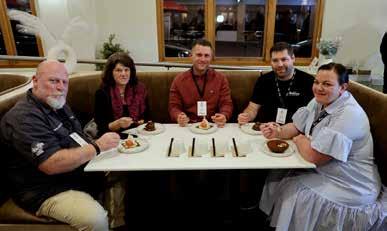


















THEMING THE OLD SIGN STUDIO WHEELHOUSE

THEMING THE OLD SIGN STUDIO R D ELECTRICAL
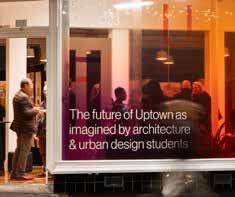
GLASSWORK BLINK LIMITED THE UPTOWN FUTURES FESTIVAL

WAYFINDING AND NAVIGATION SIGN FX - FREEMAN SIGNS LTD TE MĀTĀWAI
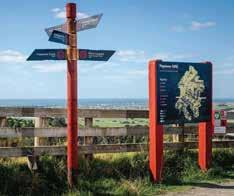
WAYFINDING AND NAVIGATION LAW CREATIVE
PAPAMOA HILLS REGIONAL CULTURAL HERITAGE PARK

DIMENSIONAL SIGNAGE & MODELLING LAW CREATIVE
PAPAMOA HILLS REGIONAL CULTURAL HERITAGE PARK - CULTURAL ENTRANCE WAY

DIMENSIONAL SIGNAGE & MODELLING LAW CREATIVE
PAPAMOA HILLS REGIONAL CULTURAL HERITAGE PARK - 3D MAP
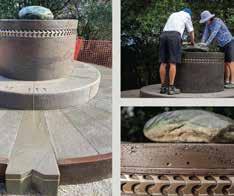
DIMENSIONAL SIGNAGE & MODELLING LAW CREATIVE
MAUAO - MOUNT MAUNGANUI - CULTURAL MANIFESTATIONS

TRADITIONAL HANDCRAFTED SIGNS & ILLUSTRATIONS
LOWE CREATIVE HARLEY PLAQUE

TRADITIONAL HANDCRAFTED SIGNS & ILLUSTRATIONS
THE OLD SIGN STUDIO WHEELHOUSE

DIGITAL ILLUSTRATIONS AND MURALS SIGN NETWORK TRAFFIC COP BAY

ORIGINAL IN-HOUSE DESIGN LAW CREATIVE MAUAO - MOUNT MAUNGANUI, TAURANGA

ORIGINAL IN-HOUSE DESIGN BLINK LIMITED UPTOWN FUTURES FESTIVAL

SELF PROMOTION BIG BROWN INDUSTRIES LTD NGĀ MĀHANGA (THE TWINS)

WORK BY AN APPRENTICE APPRENTICE: JAY ISGROVE BIG BROWN INDUSTRIES
ANIME GULF MINI

What is the origin story of WiseNav and how did it come to fruition?
Ralph: I defined the initial concept for WiseNav during a research project at the Delft University of Technology. As a senior Geomatics student, I believed that Geographic Information Systems (GIS) would one day be used for indoor pedestrian navigation.
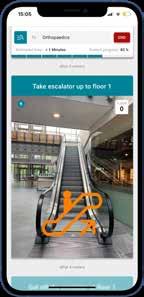
In 1978, my father, Jan Michels, began working for Modulex, a global leader in signage and graphics, specialising in directional and wayfinding solutions. For almost 40 years, he worked on complex wayfinding projects in hospitals as a design consultant.
I told my father that it would only be a matter of time before he wouldn’t need to sell any signage at all. Those words sparked an eighteen-yearlong discussion about how an electronic device equipped with GIS could assist patients in finding their way in hospitals. I
eventually came up with the idea of using pictures, as this mirrored how human wayfinding reasoning naturally works. For the first time, Jan said, “Yes, this is going to work.” Thus, WiseNav was born.
What was the feedback like during the testing phase of WiseNav? Were there any unexpected insights or challenges that emerged?
Ralph: At first a native iOS and Android app was the answer for us, or so we thought... But, oh boy, were we wrong. Turns out, people didn’t want to download apps just for finding their way around indoors. It didn’t matter if the app was top-notch; people just didn’t do it. Our competitors faced the same problem.
But this is where the magic of innovation shines – from an App-centric strategy, we pivoted to an API-centric strategy. The key insight? Wayfinding needed to seamlessly integrate into digital journeys, be it for patients, visitors, or travelers.
Our most significant blunder transformed into our greatest asset. Our mistaken appcentric approach led us to create a digital wayfinding solution that can be integrated into strategic communication touchpoints in a very simple way and provide personalised wayfinding information to users.

In what ways does WiseNav differentiate itself from other wayfinding solutions currently available on the market?
Ralph: It does not use an indoor map interface. Research indicates that maps are far from ideal for navigating indoor environments. Another important aspect is that WiseNav is API-based, so you can start your navigation directly from the touchpoint. People generally do not have



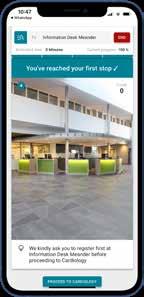

a wayfinding problem until they suddenly find themselves lost. At that point, they’re unlikely to visit the app store to see if there’s a wayfinding app for the building, download it, and learn how to use it. By that time, they would have already asked for directions.
How important was inclusivity in shaping the design of WiseNav?
Ralph: Research indicates that people prefer to follow a route, rather than using a (cognitive) map. When given verbal directions to follow a path or route, people tend to take virtual pictures in their mind and try to remember the navigation instructions that tie them all together. This works for 3-4 simple instructions along a route, but for longer routes with bends and turns in an indoor environment, we tend to forget. This is where WiseNav comes in; it is a visual narrative that helps you complete a journey without having to remember the instructions.
WiseNav was built using universal design principles, meaning “the design of products and environments to be usable by all people, to the greatest extent possible, without the need for adaptation.” However, this does not mean it is inherently inclusive. What works for a small subgroup X may compromise usability for a very large subgroup Y. It is a product design balancing act, which is very complicated. The goal of creating beautiful and functional environments that can be used equally by everyone, irrespective of age, gender, or disability, requires a design process that must constantly expand to accommodate a diverse range of users, as we develop a greater understanding of their requirements. Trying to fit everything into one product design is impossible. The nature of our product makes it accessible for physically impaired people and those with low literacy, it can also be used in any language, making it accessible for non-local people who don’t speak the language.
How did you ensure that WiseNav remains adaptable to the ever-changing dynamics within environments, such as renovations and layout changes?
Ralph: 98% of the changes that occur in large buildings like hospitals can be addressed directly within a few minutes or require an hour of work from the onsite manager. In rare cases involving major renovations, we assist the client in implementing the changes. You cannot change your signage every two weeks, but adapting with WiseNav works very well in helping visitors navigate through an everchanging environment.
How did you discover Ralph’s technology and what was involved in bringing it to New Zealand?
Michelle: Having worked with the NHS for many years trying to solve the wayfinding conundrum, I developed a keen interest in finding a wayfinding solution that actually works. While going down this rabbit hole, I came across Ralph and was blown away. His technology provided a solution to every wayfinding problem that I had ever encountered. That night, I was so excited that I couldn’t sleep. I knew that this technology was a game changer.
Michelle: After introducing Ralph to Shae (Co-Owner of Wise Studios and NZSDA President) and Luc (Co-Owner of Wise Studios), we flew to Holland to meet with him, but not before testing the technology for ourselves. The day before we landed in Holland, we received a text message inviting us to a hospital just outside of Amsterdam. This message provided a link that allowed us to view all the directions from the comfort of our hotel room, familiarising us with the hospital.
Upon landing in Holland, we clicked on the link again and selected how we wanted to travel. The application quickly integrated with Google Maps and directed us not only to the hospital, but to the correct parking area for that department. Once we’d parked, we followed the photo navigation all the way to our fictious appointment. And even though all the signs we in Dutch, we did not get lost! In fact, 96.8% of users find their destination first time using WiseNav. The application then directed us back to the car. We were sold. If we could find our way using this in a foreign country, then anyone could use it.
So here we are! We quickly signed a deal with Ralph granting us exclusivity for Australasia, and we are now ready to bring WiseNav to complex environments here. Although designed for hospitals, we would love to see this technology used in universities, large corporate offices, hotels, and airports. Imagine how stress levels would be reduced if airline passengers could use WiseNav to find their connecting flight!


Founded with the vision to revolutionise the way businesses communicate their brand to the world, Sign On has established itself as an industry leader in New Zealand’s signage sector. With a rich heritage that spans over 25 years, Sign On has been at the forefront of adopting technological advancements and creative methodologies to deliver signage solutions that cater to a range of client’s brands.
The company’s journey is a testament to its unwavering commitment to quality, innovation, and customer satisfaction. With a team of highly skilled professionals and advanced technology, Sign On has successfully executed numerous high-profile projects, earning accolades and loyalty from a diverse clientele.
ARA | Sign On offer consultancy and strategy, concept and design, project management, installation, fabrication, maintenance, while also providing the following products:
• 3D Fabrication
• Architectural Bespoke Creations
• Illuminated signage.
• Exterior and interior building signage & Fascia’s
• Street scape
• Pylons and Free-standing signage
• Wayfinding and directional signage
• Short term promotions
• Health and safety signage
• Engineering
• Fabrication
• Painting
Understanding that each business has unique needs and challenges, Sign On offers customisable solutions to signage problem. The company’s expertise spans across various sectors, including retail, corporate, healthcare, education, and more, ensuring that every project is executed with the utmost precision and attention to detail.
From the initial consultation to the final installation, Sign On’s team works closely with clients to ensure that their branding and communication goals are not just met but exceeded. This collaborative approach has been instrumental in building longstanding relationships with clients, based on trust, reliability, and unparalleled service quality.
The recent acquisition by ARA, a leader in building services and products across New Zealand and Australia is a milestone moment for Sign On. This partnership opens new avenues for growth, innovation, and excellence. With the backing of ARA’s extensive resources and network, Sign On is poised to further enhance its service offerings, expand its geographic reach, and continue to lead the industry with groundbreaking signage solutions.

With their extensive experience in manufacturing, engineering, and building services, Sign On is now in a great position to access a wider range of high-quality materials and advanced manufacturing





captivating, and innovative signage. From eco-friendly substrates to advanced digital display technologies, the partnership ensures that Sign On can offer its clients a broader range of signage options that are at the forefront of industry trends and sustainability practices.
Furthermore, the ARA Group’s capabilities in the manufacture of custom-made materials directly contribute to enhancing the production efficiency of Sign On. This means that not only can more sophisticated designs be realised with precision and finesse, but the timelines for delivering these projects can be significantly reduced. Efficiency in production without compromising on quality is a critical factor in maintaining competitiveness in the fast-paced signage industry.
Wayne Lee Nel
General Manager
Lee Joubert
Administration Manager
Shelley White Financial Administrator
Mike Archer
National Sales Manager
Laney Perry Senior Designer
Jagjit Singh
signage solutions that help businesses make a lasting impression.
As we look to the future, Sign On is more committed than ever to elevating New Zealand’s signage landscape, driving brand visibility, and helping businesses communicate their stories more effectively.
In an ever-evolving industry, Sign On continues to set the standard, blending creativity with technology to deliver signage solutions that are not just signs, but beacons of brand identity and communication.
Ryan Christie Regional Sales Auckland
Jake Connon
Delivery Manager
Chris Friis
Executive Designer
Aaron Baker
Industrial Designer
Mark Thomson

Rebecca Milham Production Manager
Chris Wheeler Signage Technician
David Craike Signage Technician
Zeus Guillem Signage Technician
Naumai Hemopo


Auckland-based Big Ideas Group has been the creative force behind Emirates Team New Zealand, designing and producing all their graphics for over two decades. Beni Hall, Account Manager for Big Ideas Group, takes Image NZ behind the scenes of this impressive project.


We have a strong understanding of how Emirates Team New Zealand operates with cutting-edge technologies and enjoy pushing every boundary with them as an extension of the design team and boat-building team, which we thrive upon, explains Beni.
Our journey begins with a brief from Grant Dalton, where we extract every detail of his vision and transform it into a visual experience. This campaign is focused on one word: “FUTURE.” With this in mind, our super-talented creative team, headed by Alissa Smith, came up with a colourway and graphic that oozed the brief. Needless to say, it was over the line in a heartbeat.
For this boat, known as 2.5, also the boat that won the cup for New Zealand the second time in a row in 2021, we printed a one-piece graphic using our trusty old HP 360 at a length of 26 metres long. In the past, all the graphics and signage had been masked and sprayed into the boat’s paintwork, but as 2.5 was the training horse, we could get away with a decal. The fundamentals of these wicked machines have changed so radically now, with them precariously dancing and hovering on a foil rather than the belly of the hull.
The entire graphic was edge-sealed, knowing the speeds these machines get up to and that when there is an oopsie (and there are a few), they fall from some 50-plus knots to zero in a split second, from 2 -3 metres above the water. Hence, we did everything in our power to eliminate the lifting of graphics.
As we are all well aware, the prep and cleaning is the answer to a successful application, and this boat was no different. First, we wipe it with “wet” IPA, then give it a second wash down with another round of IPA and a wipe down with a dry cloth. Once just process was done, we then prepositioned the 26-metre decal and started the application process. It took us approximately four hours per side with four sign techs on hand per side.
The product of choice was Avery 1105 with 6460 Gloss over laminate.
Boat 3, currently under construction, will be the race boat we use to secure the America’s Cup for the third time in a row later this year in Barcelona. We will use a mixture of digital print, mask and spray graphics, and logos. The reason why paint has always been the product of choice is because vinyl is heavier per square metre when weighed next to paint. Extra weight on these machines is the elephant in the room, and anything will be done to save a fraction of a kilo.
Keep your ear to the ground for the launch of Boat 3; I’m sure you will see her as a visual symphony as well, concludes Beni.




Find out how we can help

After spending several years in the visual effects industry, Ryan Rogers decided to channel his expertise and passion into establishing Wilde Signs NZ , a prominent sign company located in the heart of Miramar, Wellington. Although initially focusing on bespoke dimensional and illuminated signage, Wilde Signs has since evolved to offer a comprehensive range of services, including design, CAD, fabrication, and installation of a diverse array of client-requested projects.
One of Wilde Signs’ most notable achievements is the versatile plinth display at Wellington Airport, a testament to the company’s capabilities and craftsmanship. Tasked by Wellington Airport to create a dynamic display piece, Wilde Signs embraced the challenge with enthusiasm and creativity.
The Wellington Airport display is not just a sign; it’s a sophisticated stage featuring various signage and architectural elements. Collaborating closely with artist Taupuruariki (Ariki) Whakataka Brightwell, Wilde Signs brought her artwork to life through a dimensional Taniwha activation that fills the display. The artwork portrays Ngake and Whātaitai, the taniwha who once inhabited Te Whanganui-a-Tara, in a bespoke installation reflecting Wellington’s hills and harbour. The feature artwork acknowledges the 2023 FIFA Women’s World Cup in Aotearoa and the mana of wahine in Māori culture.
The stage and backdrop design draws inspiration from Wellington’s rugged hills and iconic harbour. The arch shape of the stage mirrors the curves of the harbour, while the geometric back wall and acrylic fencing represent the region’s diverse terrain. Including a smaller version of the iconic “Windy Wellington” sign adds the finishing touch, paying homage to the city’s famous weather and its film production facilities.
Crafted with an MDF substructure, satin black ACM cladding, a gloss black acrylic top,




and clear acrylic barriers, every aspect of the display/stage was meticulously crafted in-house by Wilde Signs’ team of skilled professionals. Manufacturing the “Windy Wellington” sign involved extensive CAD work and CNC programming to route corrugated patterns into the faces of the acrylic, mimicking the original sign and creating intriguing light effects. From the illuminated sign to the intricate metalwork, welding, CNC cutting, fabrication, and electrical work, Wilde Signs ensured that every detail of the plinth met the highest standards of quality and craftsmanship.

Even the TV monitor stands were customdesigned and manufactured in-house to aesthetically display the monitors on the stage, further highlighting Wilde Signs’ commitment to excellence and attention to detail.
Originally designed to celebrate women and Wellington during the FIFA Women’s World Cup 2023, the stage has since become a permanent fixture at Wellington Airport, serving as a visually stunning display piece for visitors from around the world to enjoy. The display has also hosted Marvel
Introducing Astariglas ® Eco Cast acrylicthe new innovation in eco-friendly materials.
Why Astariglas ® Eco Cast?
Eco-Friendly. Crafted from 100% Recycled Materials
Versatility for a wide range of applications

Superheroes to promote the premiere of the Marvel: Earth’s Mightiest Exhibition, held at Takina over the summer. We eagerly anticipate the next activation of the stage.
The success of the Wellington Airport display is a testament to Wilde Signs’ ability to bring a project from concept to completion. With their extensive knowledge, experience, and skill, Wilde Signs NZ has established itself as a leader in the sign industry, delivering innovative and visually striking solutions to clients far and wide.


In this issue, we catch up with Devon Garmonsway from Sign On, Taupo who shares her journey so far.


I have now been in the sign making industry for eight years, though recently I embarked on a new chapter as a mum to my beautiful baby girl, temporarily stepping back from the vibrant world of signwriting. The joy of my work extends beyond the workshop and it’s a delight to drive through different towns, pointing out to my family the various projects I’ve left my mark on. Witnessing my creations scattered across New Zealand fills me with a unique sense of pride and accomplishment.
A standout chapter in my journey was the volunteer Great Lake Taupo caravan wrap. I only had a vague description to work from, an ‘80’s feel’ based around Lake Taupo. After securing sponsorship for print materials, I plunged into the project headfirst and designed a concept incorporating bright colours and stylism of the region, in a uniquely nostalgic approach that reminded the client of the old, traditional ‘kiwi summer’. It was a journey of learning and problem solving on the go with the outcome being a flawless wrap and a delighted customer. I then was proudly awarded gold at the NZSDA awards in 2023, under the category ‘Work by An Apprentice.’
In quieter moments, I eagerly join the hustle of the application bay, turning the task of wrapping cars into a friendly competition with my workmates. Competing with those who wrap cars daily, I take pride in not just keeping pace but in delivering satisfying results. Working at Sign On, a bustling sign shop, exposes me to endless possibilities, injecting each day with variety and excitement.
My dedication also extends to the apprenticeship book work. Thoroughly completing it is not just about meeting requirements; it’s an ongoing quest for knowledge. I find myself going beyond what the book asks, fixing things and adding extra info, aiming not just to do the job but to truly understand it.
A change of scenery can trigger a professional switch in my brain. Walking down the street, my attention is often captivated by a shop window covered in bubbles. My dedication to detail kicks in – I simply can’t walk away until it looks better. My daily adventures in the signwriting industry are fuelled by enthusiasm, turning what might be a routine job into a continuous adventure.
For those considering a leap into the signwriting industry, Signwriting goes beyond being just a job or skill; it’s a daily opportunity to express creativity through a hobby. To those pondering the idea, consider this your nudge to dive into the world of signwriting – where every shop window and every vehicle can be your canvas.










Elite Signs are the leading wholesale signage manufacture and installation company within New Zealand. Established in 1999, we supply signage to the industry only. We are a highly skilled, motivated team of tradespeople, who take much pride in our ability to provide you with expert design, manufacture, and installation of all signage requirements.
Some of the equipment and the services we can offer
• Aluminium/steel welding, pylon signs, sign poles - frames - brackets - bolt cradles/reinforcing
• Laser and CNC router cutting ( 4000mm x 1580mm wide bed)
• Acrylic and aluminium 3D fabricated shapes/letters
• LED illuminated signage from sign cases to custom shaped, fabricated signs and 3D lettering of your choice
• Neon signs and repairs
• Producer statements, structural engineer certified
• Graphic application service
• Complete signage de-image and re-image
• Full installation service
Our passion, skills, and dedication to achieve the highest quality results is what sets us apart from others. We are in all projects with you, taking shared responsibility for your goals and vision, working with you to achieve and make your goal a reality.

Two major campaigns run in July. Dry July and Plastic-Free July. The goals are similar: to raise awareness of a cause, educate or change habits and behaviour for healthier outcomes.
Both equally can feel like an impossible challenge. Plastic Free July reminds us of the pervasive and enduring presence of singleuse plastic in our environment. While this should be a genuine concern, the danger is that it can contribute to the backlash against plastics and exacerbate the belief that all plastic is bad and best avoided.
The mere mention of the word "plastic" conjures up images of littered beaches and marine life choking and entangled in plastics. We are reminded every day by the media of the devasting impact of plastic. We are acutely aware that microplastics have entered every corner of the earth, ecosystem and the human body. Even a small piece of thermal blanket that detached from the
remote vehicle Rover as it traversed the surface of Mars was touted as plastic trash left on the planet.
However, its representation in media is also skewed. We rarely see stories celebrating plastic for saving lives or reducing carbon emissions. Plastic can contribute as much to sustainable outcomes as it can destroy them.
It is important to distinguish between different plastics. We tend to talk about plastic as though it is one thing, yet there are seven different categories of plastic and many variants and compositions within each. Not all plastics are equal in terms of benefit or
harm. Thanks to the ongoing narrative against plastic, we are swayed by terms like "plasticfree" and led to believe that something must be good simply because it does not contain plastic.
As an industry, we are large consumers of plastic, from rigid boards, acrylic and corflute to banners, synthetic paper and self-adhesive films. While the materials we use are not in the same category of harm as a wayward plastic bag or discarded straw, they are nonetheless plastic. As such, our industry will increasingly be affected by people’s perceptions about plastic in general. We cannot distance ourselves from the war against plastic. We also cannot deny that the materials we use have an

impact on the environment. We are, after all, converters and suppliers of plastic as a solution for visual communication and branding. Like any large plastic provider, we will be under the same scrutiny when it comes to people engaging with our products and services.
The impact is happening already. As brands and businesses work to improve their own sustainable practices, their focus is expanding to their supply chain, and this includes signage and print. As print buyers become more conscious of our materials, there is an increasing demand for more environmentally friendly solutions; for some, plastic is on the chopping block. As we are starting to see in other markets, large retailers are requesting PVC-free products or moving away from plastic altogether. The use of paper, boards, textiles and digital signs is increasing to reduce the impact of print advertising, display and decorative applications on the environment. The perception is that these alternative materials are better for the planet, but that isn’t always the case.
We need to be pre-emptive regarding the changing needs of customers. By educating and engaging with our customers around sustainability, we can ensure they choose genuinely sustainable and commercially viable solutions. If we don’t, we risk customers making material decisions based on a limited

understanding of substrates and negative perceptions, which in the long run can cost us business.
The biggest problem with plastic is waste and the impact it has on the environment at the end of its life.
We can make better choices around the materials we use and where we use them. We can offer solutions that create less environmental burden by choosing less toxic plastics, recycled plastics, and plastic substrates that can be recycled at the end of life. We can show that some plastics can be as sustainable as other alternatives and
commercially viable. Sustainability and using plastic don’t have to be mutually exclusive.
As Plastic Free July highlights the negative aspects of single-use plastic, it is also a reminder for us to address our own use of plastic and where the synergies are. The feelings people have about plastic will increasingly impact our industry and the sign and print solutions customers invest in. By being prepared and taking the lead, you can meet the demands of your customers while also ensuring positive commercial outcomes for your business.
DENISE KIRBY has nearly thirty years’ experience supplying self-adhesive media to the sign and print industry. Initially starting out in the family business as a distributor, she went on to work for leading self-adhesive manufacturers in marketing, business development and product management roles across Australia and New Zealand. She now has her own business, Kirbyco, which develops and supplies eco-friendly, recyclable and sustainable print media, and created ZERO, a product stewardship scheme which recycles end of life printed media. Denise is highly passionate about the industry and enjoys writing about applications, opportunities and new developments in print and signage. Her goal is to inspire people to explore new creative, functional and sustainable opportunities in print as well as educating the industry on products, trends and innovations.


This is a very real truism if I’ve ever heard one. As business owners, cash flow, or even better, cash, is what fills our business lungs on a daily basis. It is the oxygen of our business life. Without it, it’s a very real and difficult struggle. Every business owner will have been through periods where a major client fails to pay on time, or you’ve had to pay a substantial cash outlay that leaves our cash flow struggling like pushing water uphill.
When it comes to selling your business, it's a deeply emotional decision. You've invested your heart and soul into building this business, and the thought of parting with it for anything other than cold, hard cash is a tough pill to swallow. However, the realities of selling a business often present a different picture. And this is before considering finding a purchaser, let alone assessing if they are the right buyer. During our process, around 15-20 people met and inspected the business, with many considering offers of partial purchases or delayed payments.
Prior to considering selling Kingman Visual, we spent several years making sure we had our ducks in a row. We meticulously prepared all the systems and processes that make a business more attractive, especially to a non-trade purchaser. We had clearly defined departments and, where possible, department heads who reported back to senior management. A clear and
logical reporting system showed accurate and timely reporting. We understood that a buyer needs clarity in every aspect, and we were ready to provide it.
After this preparation, it was time to interview business brokers and decide who we trusted the most to sell our beloved entity. Who understands the decades of effort that’s gone into this and your desire to be well recompensed for those years of hard graft? I decided to appoint two brokers. This is unusual, but our business had a good chance of being purchased from an East Coast-based buyer, so I decided on someone on the East Coast and a West Australian-based broker.
All the brokers I spoke with shared a common theme that caught me off guard and gave me my first reality check. The chances of finding a cash buyer for a business the size of Kingman Visual were unheard of. Over 90% of business sales in this price range are sold with a varying
degree of vendor finance. It was then a case of how much cash and how much we were willing to risk or rather loan to the purchaser.
It was rather difficult and unpalatable to consider this. After 38 years of building this business into the company it was, it was hard to process that we would or should have to consider financing it ourselves. On top of the vendor financing, many purchasers want to see earn-out conditions as a part of the process. That is, you get a percentage, say 50% upfront, and then the final price and balance are determined at a point down the line, say, two years. This figure is based on maintaining or improving your historical sales and profits. Generally, in these circumstances, the original owner stays on in a handover role to ensure the business does, in fact, maintain those figures. For example, if your average historical profit is $1,000,000 pa, then under the new ownership, and for whatever reason, profits drop by 20%, then so does

that last payment. Similarly, if your profit increases, and it should in reality, then your final payment also increases. And it is for that reason that it’s in your best interest to stay on in some capacity.
In the cold, hard light of day, and with 20/20 hindsight, it did, in fact, prove prophetic for us. Many contemporaries have asked me why on earth I agreed to a vendor loan arrangement, and perhaps, even brutally, it was my fault to accept such terms.
Well, the above explains why and in the aftermath of the atrocious management of the company under new ownership, we were left with around $800,000 short of our total payment. It is hard to digest for anyone, regardless of value or private worth, that’s a big sum to “lose.” Why did I italicise the word “lose”? Well… we never
had that money; it was just money owed to us, so we didn’t actually “lose” that money. The reality is that our children will miss out on that money as we have invested wisely and are comfortable without it. It’s just a bitter pill to swallow. We ensured we received enough at settlement and told ourselves that if this is all we get, we’re okay financially. And we knew on day one it was going in a direction we couldn’t foresee. They didn’t keep me on for any handover, not even for one hour.
Now, you could justify that to the departments and management system I put in place for that exact reason. Still, every business has its own idiosyncrasies that aren’t obvious to new owners. Even though we did receive 12 months of vendor loan payments after settlement, we didn’t get paid for stock on the floor or work in

progress. And the only recourse we had as ex-owners is via the court system. I have had reason to use legal action over the years, and whilst the process is agonisingly long and slow, I always found the justice system worked in the end. But, it is slow and expensive. We were at the penultimate stage in that legal action against the new owners when Kingman collapsed, owing over $7m in debt. We and our wonderful suppliers will see no money from the liquidation process at all. So many clients got caught in the mix as well, having made significant progress payments and then being refused access to their goods until the process was completed. It’s a messy end, but I accept our decision in vendor loans. It will come down to each person as to what you are willing to do. It was time for me to move on after 38 years at Kingman and over 50 years in the industry, and I was emotionally retired.
We received two offers on the same day, one from a WA-based entity that was the final buyer and an East Coast company wanting a national footprint. Please remember this was mid-2020, in the midst of Covid, so the East Coast Company couldn’t travel to Perth to inspect but were still willing to proceed. On that basis, we chose the local buyer, and the rest is a sad and tragic historical note.
How do you sell your business without risk? Without a cash buyer, I still believe in the process. But I’m a much more seasoned person now in the process. I wish you every success if selling your business is in your future.

Providing outstanding service is undoubtedly crucial for any small business. Yet, despite our best efforts to deliver prompt and high-quality service, many small business owners hit a growth plateau. The truth is that offering exceptional customer service alone won’t guarantee new business growth.
Recently, we conducted research on behalf of a well-known print brand. We wanted to understand how they treated inbound enquiries and how proactive they were at exploring the potential behind an inbound lead. What we found was both impressive and concerning!
Sellabilities is a sales training company, and we often need to produce printed Participant Workbooks for our programs. So, using one of our standard print requests for a job that would typically be worth $4,000-$5,000, we sent enquiries off to businesses across Australia that we'd never done business with before. The results are noteworthy:
• 94% of the businesses responded with a quote within 24-48 hours
• 30% of the businesses attempted to call or email us to clarify some minor details
On the plus side, what we experienced was exceptional customer service. Both responsiveness and turnaround times were impressive and better than we had anticipated.
On the flip side, whilst not unexpected, we were very concerned about the small number of stores that took the time to try and contact us. Remember, these stores had never done business with us before, and they had just received a job request for work that is likely to be a value that is much higher than their average invoice.
These results beg the question, how do these business owners treat inbound requests from existing accounts?
As small business owners, we must shift our focus from mere transactional exchanges to cultivating deeper, more meaningf ul
relationships with our clients and prospective clients. It's about going beyond the surface level of excellent customer service and delving into the realms of proactive engagement and strategic partnership.
Consider this: How well do we truly know our top clients? Are we familiar with their business goals, pain points, and aspirations? Or are we content with providing what they ask for without understanding the bigger picture?
A recent article from Gartner highlights that delivering service and driving growth are distinct endeavours. While exceptional service and high satisfaction levels certainly contribute to customer retention, they don't necessarily translate to business growth. Small businesses must recognise the difference and avoid getting trapped in what Gartner labelled the 'zone of wasted effort'. This 'zone' is characterised
by salespeople overinvesting in the account through exceptional service levels, assuming that it will lead to additional business. Unfortunately, that’s simply not the case.
Instead of fixating solely on service delivery, small businesses should also focus on activities that truly drive growth. Gartner’s findings suggest that customer improvement is the most significant driver of account growth, and this approach involves providing customers with unique, constructive perspectives on how they can enhance their businesses, along with laying out a vision for future improvement. Demonstrating the ROI of implementing the suggested changes is also key.
Gartner also emphasises the importance of focusing on the customer’s future opportunities rather than dwelling on past transactions or your products. Additionally, it would be best if you avoided aggressive selling. However, by adopting a customer-centric approach and actively engaging in activities that foster customer improvement, small businesses can break free from the ‘zone of wasted effort’ and unlock new avenues for sustainable growth in a dynamic marketplace.
So, how do you unlock new avenues?
We need to adopt a more curious mindset to unlock the potential for growth within our potential new and existing client base. Instead of just being incredibly responsive,
fulfilling orders and providing exceptional customer service, let’s take the time to ask different questions, seek a deeper level of understanding, delve into their challenges, and truly understand their business landscape.
Research plays a pivotal role in this process. By leveraging tools like customer surveys, market analysis, desktop Google searches and industry reports, we can gain valuable insights into our clients’ needs and preferences. Additionally, engaging in active listening during client interactions can uncover hidden opportunities for improvement and innovation.
One approach we would encourage you to consider is focusing on your top 20-30 accounts—the clients who consistently bring you the most value and see you as their trusted partner. Rather than treating them as just another customer and offering your usual customer service, let’s view them as strategic partners in your business journey. By investing time and resources into understanding their unique problems, needs and aspirations, you can tailor your solutions to deliver enhanced value.
To do this is quite simple. The next time you receive an inbound job request from them, take the time to review the request and think about how the work could be improved, enhanced, or changed in some way that the customer may value. Then, pick up the phone and speak to them about it. As a trusted partner, they are
highly likely to give you their time and value your thoughts.
Of course, this process doesn’t replace contacting any customer when you have specific questions about their request. It works in parallel with that and provides an opportunity to clarify and potentially expand the opportunity.
Importantly, it’s not just about selling products or services; it’s about providing solutions that address our client’s specific pain points and challenges to bring improvements to them. This requires a proactive approach, where we anticipate their needs and offer innovative solutions before they even realise they need them. We take the approach that their business is an extension of ours and proactively look for ways to improve their business. Which, in turn, means our business will also grow.
While great service is undoubtedly essential, it’s not the sole driver of business growth. Small business owners must embrace a proactive, curious mindset to thrive in today’s marketplace. By deepening our understanding of our top clients’ businesses and offering tailored solutions that improve how they do what they do and what they do, we can unlock new growth opportunities and solidify our position as trusted partners in their success journey.
Sellabilities is a registered trademark
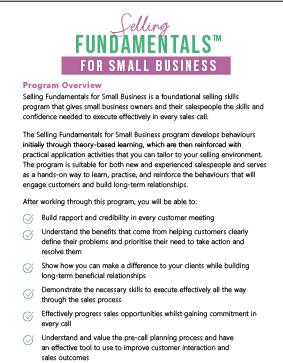





Activities & worksheets for you to
& worksheets for you to work through at your own pace work through at your own pace
Providing comprehensive services that include:
• 3D Fabrication
• Architectural Bespoke Creations
• Illuminated Signage
• Exterior and Interior Building Signage and Fascia’s
• Street Scape
• Pylons and Free-standing Signage

• Wayfinding and Directional Signage
• Short Term Promotions
• Health and Safety Signage
• Fabrication
• Engineering
• Painting